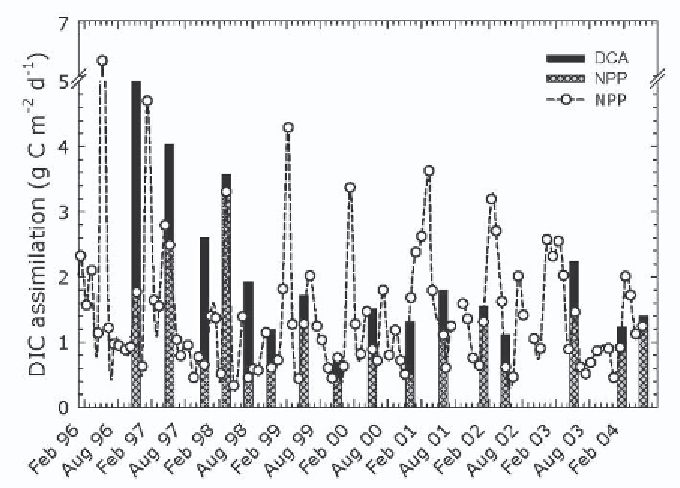Environmental Engineering Reference
In-Depth Information
Figure 8.
Monthly variation in net primary production (NPP) and seasonal variation in dark
DIC assimilation (DCA), integrated over 0-100 m and 250-450 m intervals, respectively. Total
bar height is sum of photoautotrophic production (hatched portion) and dark DIC assimilation
(solid portion).
of DIC through one or more chemoautotrophic process is operative in the
redoxcline. Inhibition experiments strongly suggest that most DIC assimilation
immediately above the O
2
/H
2
S interface is performed by nitrifying bacteria.
Addition of a specific nitrification inhibitor, N-Serve (nitrapyrin), dramatically
reduced DIC assimilation in samples 10 and 25 m above the interface while
having no inhibitory effect on samples in sulfidic waters (Fig. 9a). A NO
2
−
peak in the redoxcline and
15
N isotopic signatures are additional evidence for
a nitrifying layer residing immediately above the O
2
/H
2
S interface [45,56,59].
Experiments in which replicate samples were amended with likely electron
donors or acceptors were performed on six cruises and produced mixed results
(Fig. 9b,c). On different occasions, amendments of H
2
S, S
2
O
3
and S
0
stimu-
lated dark DIC assimilation 2 to 30-fold, had no effect or became inhibitory with
no apparent depth trend. Ammonium amendments only produced 2 to 3-fold
stimulations in sulfidic waters and appeared to exert no effect or inhibit activity
in shallower waters. Below the interface, NO
3
−
, MnO
2
and Fe
2
O
3
amendments
induced 2 to 30-fold stimulations in dark DIC assimilation or exhibited no
effect (Fig. 9c). Introduction of air (headspace) seldom stimulated, and often

